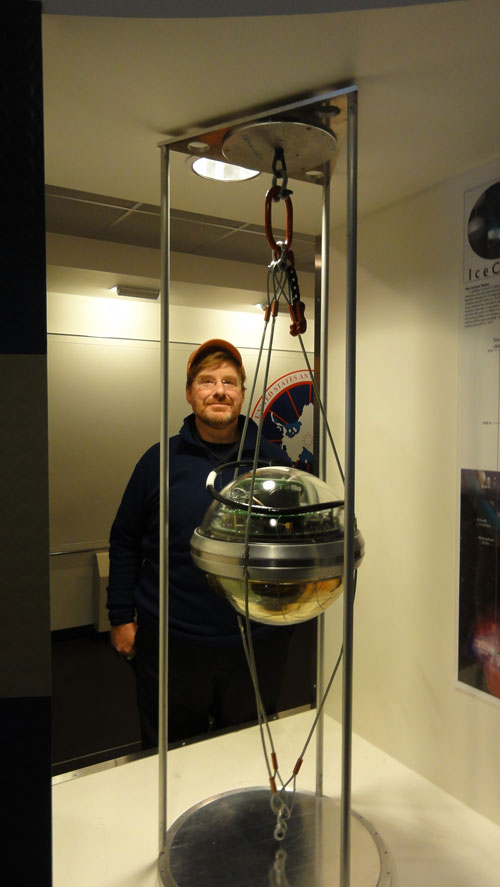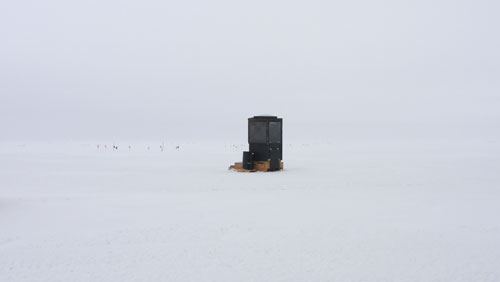At the turn of the 20th Century, waves of explorers from around the world launched expeditions to Antarctica. A few of the expeditions were derring-do races to be “first” to this or that place. Others mapped the continent, and yet others collected data and artifacts and conducted scientific experiments. Some were a mix of all of those activities.
Whatever their objectives, the men who came south were forced by the harsh, barren environment to bring building materials, supplies, and large quantities of food with them. One can still find along the coast the huts built by those explorers to store provisions and provide shelter against the extreme cold and wind. The Antarctic Heritage Trust, on which I serve as Ex-Officio Trustee, is engaged in conserving and restoring four huts in the Ross Sea area. I was fortunate to be able to visit three of those structures while on the Ice.

Hut Point, with Discovery Hut at far right.
As I noted in a prior post about my first visit in 2010, the Discovery Hut (sometimes called Scott’s Hut) sits on Hut Point, on the edge of McMurdo Station. The hut is named after the ship Discovery which carried British Royal Navy Captain Robert Falcon Scott and his crew to Antarctica in January 1902 on the first official British expedition to the continent. The party built the hut as a land base for sledge treks on Ross Island and the Ross Ice Shelf, and for an unsuccessful attempt to reach the South Pole later that year.
At Cape Royds, next to the Adélie penguin rookery that I described in my last two posts, sits the hut built by Anglo-Irishman Ernest Shackleton in 1908 on his Nimrod expedition, named for the ship that carried him to Antarctica. Shackleton had planned to establish his base on the other side of the Ross Ice Shelf at the Bay of Whales, but he was blocked first by calving ice that obliterated his chosen location and then by impenetrable pack ice. After also failing to reach Hut Point because of pack ice, he finally selected Cape Royds as his winter-over site.

Nimrod Hut, at Cape Royds.
Shackleton launched several successful expeditions from the Nimrod Hut, including being the first to reach the magnetic pole and the first to ascend Mt Erebus. He also had the perhaps ignominious distinction of bringing the first motor vehicle to Antarctica. Nature fought back, and the automobile proved useless in the snow
In December 1908 Shackleton made an attempt on the geographic South Pole but fell 97 miles (156 km) short. As his supplies ran low, he calculated that his team could make the Pole but would be unable to return all the way to Cape Royds. As he later told his wife, “I thought you’d rather have a live donkey than a dead lion.”

Mike in Nimrod Hut.
I visited both the Discovery (Scott) Hut and the Nimrod (Shackleton) Hut during my 2010 trip. I had planned at the time to visit a third structure as well, the Terra Nova Hut at Cape Evans, but extremely high winds prevented our helicopter from landing. We had to divert directly back to McMurdo so that we wouldn’t be forced down and stranded for the night. This time around we were a bit luckier with the weather.

Terra Nova Hut, at Cape Evans.
The Terra Nova Hut, again named after the ship that carried the party of explorers to the Ice, was a pre-fabricated structure erected by Captain Scott in 1911 on his second and last Antarctic expedition. The hut was the largest of the structures built during that era, and it provided greater comforts as well as more space for the men.

A section of the sleeping quarters in Terra Nova Hut.
As Scott himself wrote in his diary, “The hut is becoming the most comfortable dwelling-place imaginable. We have made ourselves a truly seductive home, within the walls of which peace, quiet and comfort remain supreme. Such a noble dwelling transcends the word ‘hut’, and we pause to give it a more fitting title only from lack of the appropriate suggestion. What shall we call it? The word hut is misleading.”

Terra Nova's kitchen area.

A view of Scott's sleeping area, with the expedition dining table at left.
The Terra Nova carried vast stores for the expedition including more than 160 mutton and beef carcasses, cheese, butter, eggs, many dozens of crates of flour and tinned food, drums of kerosene, and a large amount of compressed coal. Scott also brought new technologies to the Ice including Burroughs Welcome medical equipment and supplies, photographic equipment and supplies, and various surveying, navigating, and scientific instruments.

I was suprised to see hundred-year-old eggs in the pantry.

We saw a variety of condiments on the shelves.

There was plenty of tinned fish and meat.
For ground transportation, the expedition brought numerous sledges, 33 Siberian huskies, two Siberian ponies, 17 Manchurian ponies, seven Indian Army mules, and three motor tractors. To keep those various engines running, the Terra Nova carried drums of Shell petrol for the tractors and tons of Geelong fodder, bran, and crushed oats for the animals.

I was startled to find this skeleton of one of Scott's dogs as I walked through the stables built along the side of the hut.
Once camp was established the impressive team of scientists included in the expedition began to take measurements, collect specimens, chart the environs, and conduct experiments in the fields of meteorology, magnetism, glaciology, gravity, geology, and marine biology.

Laboratory equipment at one end of the hut.
Scott’s primary goal was to reach the Pole. He was tantalized by Shackleton’s near success and deeply distressed by the news that Roald Amundsen of Norway was en route to launch his own attempt on the South Pole.
It had been thought that Amundsen was heading to the North Pole, but he turned his ship southward when he belatedly received news that Robert Peary of the United States had already reached that Pole first (on April 6, 1909).

Captain Scott in his corner of the hut, 100 years ago.

That corner as it looks today.
Scott selected four of his men and started for the South Pole on November 1, 1911,, using his old Discovery Hut at Hut Point as one of his supply depots. The team crossed the Ross Ice Shelf, traversed the Beardmore Glacier, trekked over the vast Polar Plateau, and reached their goal on January 17, 1912, only to find Amundsen’s tent, a Norwegian flag, and a note from Amundsen to Scott already at the site.

A personal photo in one of the bunks.
Scott wrote in his diary that day, “Great God! this is an awful place and terrible enough for us to have laboured to it without the reward of priority … Now for the run home and a desperate struggle. I wonder if we can do it.”
The party turned back. They were pounded by blizzards, slowed by injuries, and weakened as food ran out. After weeks of arduous effort, they perished approximately 150 miles (240 km) from Hut Point, and just 11 miles (18 km) from a field supply depot that they had established on their way to the Pole.

A shoe left behind in the hut.
The century-old huts and their well-preserved contents are extraordinary reminders of the great spirit, courage, endurance, and ingenuity of the explorers who first landed on the inhospitable shores of Antarctica. As the wind howled and the snow blew beyond the walls, I walked briefly in their footsteps and communed with the refuges they created in the alien environment. It was the poignant personal touches at the end of the world – a family photograph, a shoe, a postcard picture of home — that I found most powerful.
![]()
 RSS
RSS























 View my Profile
View my Profile Connect with Wellington
Connect with Wellington Watch our Videos & Subscribe
Watch our Videos & Subscribe Watch our Videos on Vimeo
Watch our Videos on Vimeo Connect on GPlus
Connect on GPlus US Embassy NZ
US Embassy NZ


 Post Entries (RSS)
Post Entries (RSS)

